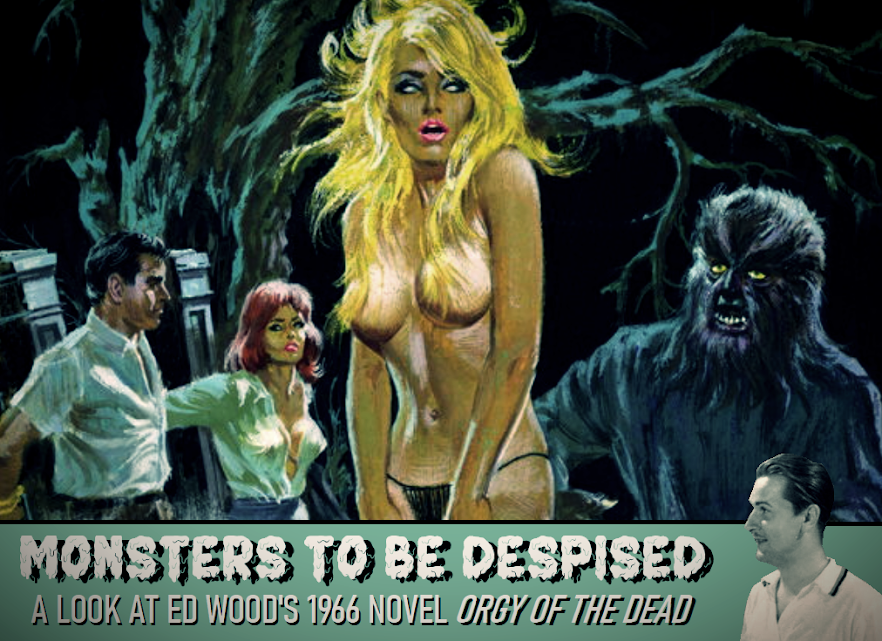 |
| Something about this particular story must have really captured Ed Wood's imagination. |
Early in Tobe Hooper's The Texas Chainsaw Massacre (1974), a psychotic hitchhiker (Ed Neal) explains to a vanload of horrified hippies how the delicacy known as "head cheese" is made:
They take the head [of the cow] and they boil it, except for the tongue, and they scrape all the flesh away from the bone. They use everything. They don't throw nothing away. They use the jowls and the muscles and the eyes and the ligaments and everything! From the nose and the gums and all the flesh, and they boil it down into a big jelly of fats!
 |
| Ed Neal as the hitchhiker. |
There is one particular plot that turns up at least three times in Ed Wood's literary canon, and it's a perfect metaphor for how Eddie worked. It tells of a disreputable mortician who bilks grieving families out of their money and blatantly abuses the helpless corpses placed in his care, sometimes for profit, sometimes just for fun. To put it mildly, this guy is a real scumbag: a liar, a thief, a necrophile, and a desecrator of graves. Even though he is eventually found out and must face the consequences of his actions, his story still leaves us with a feeling of disgust. And Ed Wood kept returning to that story! I wouldn't be surprised if it turns up in more places that I just haven't found yet! But why? What, exactly, was the appeal of this story?
Well, let's examine it. As far as I know, we first meet this dastardly scoundrel in Chapter Twelve of Orgy of the Dead (Greenleaf, 1966), Ed Wood's patchwork novelization of his film script from the previous year. As I explained in my review of that book, the mortician is just one of the deceased individuals being judged by the Emperor, a mysterious cloaked figure who rules over the underworld and who holds court in a spooky cemetery on a moonlit night. Most of the other "defendants" in the novel are imported from Wood's short stories, but our mortician friend is a new creation.
 |
| The Orgy novel. |
On his first day at the funeral parlor, Lyle was overwhelmed by the sight of a deceased young woman in her late teens. This may have been the first indication of the mortician's latent perversities. Typical of an Ed Wood character, he obsessed over the woman's appearance and outfit. He became especially fixated on a handkerchief he used to wipe some makeup off the woman's face.
After a few months, Lyle began to hatch a scheme. He bought a nearby cemetery, forced the embalmer into retirement, and hired a couple of local drunks (similar to the characters from "To Kill a Saturday Night") to be his gravediggers. He also started convincing families to hold closed-casket funerals for their loved ones. That way, he was free to exploit the corpses. He sold their hair, their blood, and even their internal organs. Eventually, he started removing the flesh from the bones. That way he had two more saleable commodities: skeletons and meat. He especially enjoyed mutilating the bodies of "young girls" and then wearing their clothes. All the while, coffins full of rocks were being buried five or six deep in his cemetery.
It was quite a profitable operation, but it couldn't last. One day, while Lyle was chopping up another young woman and wearing her clothes, one of the drunken gravediggers staggered into his office. The other gravedigger had just recently died, and his sentimental coworker wanted "one last look at his buddy." Upon making the horrible discovery, the surviving drunk notified the police. After posting bail, Lyle decided to abscond with some money he had hidden away in one of the coffins he had buried. That's when a bony hand reached up from beyond the grave and dragged Lyle down to hell. The Emperor sentences the mortician to a most cruel fate: he shall forevermore be forced to wear a "frilly pink dress" that is "tattered, decaying, [and] crawling with grave mold and worms." The phony funeral director runs screaming into the woods. Interestingly, Lyle has become a "little man" by the end of the chapter. He'd been tall at the beginning of it.
The mortician's gruesome story resembles not only Night of the Ghouls, in which conman Dr. Acula (Kenne Duncan) inadvertently provokes the wrath of the dead, but also the long-unproduced I Woke Up Early the Day I Died (1997), which also revolves around some money hidden in a coffin, plus the short story "In the Stony Lonesome" (1972). Interestingly, when he's digging up the coffin, Lyle uses a lighted match to see what he's doing, just as Officer Kelton (Paul Marco) does while rooting around in Inspector Clay's grave in Plan 9 from Outer Space (1957).






